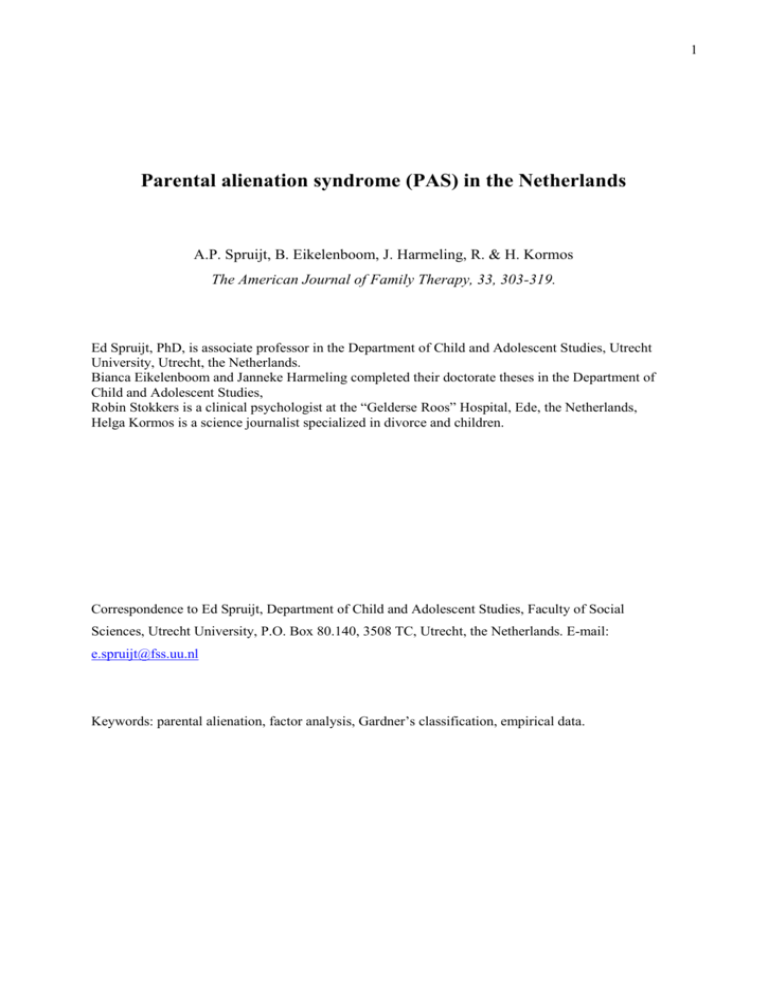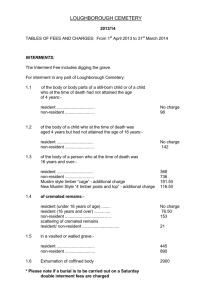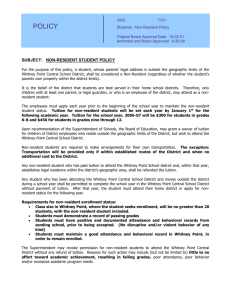The parent alienation syndrom (PAS) in the Netherlands
advertisement

1 Parental alienation syndrome (PAS) in the Netherlands A.P. Spruijt, B. Eikelenboom, J. Harmeling, R. & H. Kormos The American Journal of Family Therapy, 33, 303-319. Ed Spruijt, PhD, is associate professor in the Department of Child and Adolescent Studies, Utrecht University, Utrecht, the Netherlands. Bianca Eikelenboom and Janneke Harmeling completed their doctorate theses in the Department of Child and Adolescent Studies, Robin Stokkers is a clinical psychologist at the “Gelderse Roos” Hospital, Ede, the Netherlands, Helga Kormos is a science journalist specialized in divorce and children. Correspondence to Ed Spruijt, Department of Child and Adolescent Studies, Faculty of Social Sciences, Utrecht University, P.O. Box 80.140, 3508 TC, Utrecht, the Netherlands. E-mail: e.spruijt@fss.uu.nl Keywords: parental alienation, factor analysis, Gardner’s classification, empirical data. 2 Parental alienation syndrome (PAS) in the Netherlands Abstract In the Netherlands, about 20% of children do not have any contact with their non-resident parent after parental divorce. There are often many reasons underlying the broken contact, but one might well be the process of parental alienation, when the child denigrates and excludes the non-resident parent. This article presents the results of two studies conducted amongst divorce experts and divorced, nonresident parents. A total of 138 respondents co-operated in our studies. Of the respondents, 58% thought PAS either does not, or hardly, occur in the Netherlands, and 42% thought it does. The extent of parental alienation was classified as mild (33%) or moderate (9%). From our factor analysis, it became clear that Gardner’s classification of eight separate symptoms of parental alienation was not evident in our research data. We were able to distinguish four separate aspects: two of them concerning alienation due to the resident parent and two concerning alienation due to the child. Our results underpin the importance of mediation, since it seemed that PAS occurred significantly more often when decisions with relation to the children were not taken together by the parents but were determined in court. We consider that compulsory mediation and better communication during divorce would prevent many cases of PAS. Theoretical background Parental alienation syndrome (PAS) has become well-known particularly due to the work of the American psychiatrist Richard Gardner (1998, 2002). The phenomenon of a pathological relationship between the resident parent and child with exclusion of the other parent had already been observed, yet it was Gardner who developed a more detailed description of it. He also identified criteria to judge the process of alienation in its most serious manifestation – as a pathological syndrome (Rybicki, 2001). He also drew the attention of the justice administration to this phenomena and he urged them to combine a therapy intervention with a judicial order, always with the aim of maintaining the contact between the non-resident parent and his (or her) child (Lund, 1995). According to Gardner’s definition, PAS is a disorder that primarily occurs during a legal battle for parental custody in the adversary system. The main symptom is the child’s unjustified and denigrating attitude towards the non-resident parent (mostly the father). This syndrome arises from a combination of indoctrination by the resident parent with a contribution to the vilification by the child itself. Whenever there is a case of real abuse or neglect by a parent, the child’s animosity may be justified and PAS is then not applicable as an explanation for the child’s hostility (Gardner, 1998). Gardner distinguished three levels of PAS, namely mild, moderate and severe. Particularly severe PAS has a negative influence on the child’s psychological development. In addition, the American psychiatrist identified the eight major symptoms he often observed: 1. There is an ongoing 3 campaign of denigration against the other parent (mostly the father). 2. The arguments for the slander given by the children are weak, frivolous and/or absurd. 3. The children lack ambivalent feelings in that they declare the non-resident parent to be 100% bad and the resident parent 100% good. 4. The children claim the decision to exclude the non-resident parent as their own and the resident parent supports this ‘independent’ attitude emphatically. 5. The kids support their resident parent automatically. This could result in the child rejecting convincing evidence to the contrary. 6. The children do not feel guilty about cruel behaviour towards the non-resident parent. 7. The children, while excluding the non-resident parent, seem to recite borrowed scenarios that are quite unusual for their age. 8. The hostility expands to the family of the non-resident parent. According to Gardner, children who suffer moderately or severely from PAS show most (if not all) of these symptoms. Gardner found the threat of sanctions to be an excellent remedy for bringing the unwilling parent into line. There could be a threat to impose a fine, or to transfer physical custody of the child to the other parent or, if the worst came to the worst, a prison sentence for the parent (mostly the mother) who is frustrating visitation rights. In cases of moderate to severe PAS, a mediator or therapist must be willing and able to act in a dictatorial and authoritarian way, since only then it is possible to carry out such ‘threat’ therapy. All of this can only be effective when the therapist is backed up by the court. In order to ease the problems of children in the worst cases of PAS, it is necessary to be able to put threats into practice. According to Gardner, to match word with action, the court must indeed remove a child from the resident parent. If it is then impossible to place the child directly with the non-resident parent, the child will have to live elsewhere for a period of time. The child might need to go to other relatives, friends or be placed with a foster family. Sometimes the child may even have to be placed in a home or clinic with strict rules, where it is not particularly pleasant. During this transitional period, visitation with the non-resident parent can be built up until the child is ready to live with him. During this time, any contact with the former resident parent must be forbidden. Later on, the child may be allowed to visit the former resident parent, but only under strict supervision. One condition for initiating visitation should be less hostility from the former resident parent in order to minimalize the risk of the child being manipulated again (Gardner, 1998). According to Gardner, PAS is a direct product of the adversary legal system and involving two lawyers in the divorce jurisdiction. Only if that system can be replaced by “more civilized methods of conflict solution such as mediation”, will there be any hope of preventing PAS (Gardner, 1998). Comments on PAS In the United States, PAS is controversial. To Gardner’s merit, he has made PAS widely known. Some empirical support for his opinions certainly exists, but it applies mainly to cases studies of some individuals (Lund, 1995; Rybicki, 2001). In Europe there are Dutch fathers, for instance, who support the existence of PAS, as something they have experienced themselves (Zander, 1999). The German psychologist Kodjoe (1998; 2001) drew attention to studies of Clawar & Rivlin (1991) in support of 4 PAS. Nobody disputes the phenomenon of parental alienation in the context of conflicts about custody and visitation. However, in recent literature there have been many, sometimes sharply critical, comments made about Gardner's description of PAS (see, for example, Bruch, 2001; Johnston, 1993; Kelly & Johnston, 2001; Williams, 2001). Broadly, the comments are about: 1. The PAS approach is based on theoretical considerations that have not been tested and the model cannot be falsified. 2. Attention has been focused almost exclusively on the resident parent as the source of all evil. 3. The model is oversimplified and ignores other important factors. 4. The recommended remedy is too radical and therefore probably ineffective and damaging. 5. Gardner published his own work without having it reviewed by his peers. 6. Gardner is almost a ‘hired gun’: he promotes his own theory and offers his services as an expert. 7. The juridical status of PAS is questionable since it does not fulfil the demands for scientific evidence in court, as required by the US Supreme Court. PAS in practice Despite all the objections, PAS is steadily permeating courts in the US (Zirrogiannis, 2001) but the American legal system is finding PAS hard to cope with. The main reasons for this are that the phenomenon of PAS has been abused and the precise importance of PAS is unclear to some people. As a consequence of the adversary model in US courts, lawyers and their clients try their best to win their case and they use the PAS label hoping that it will lead to victory (i.e. the transfer of custody of the child). In this way, PAS has become “a kind of nuclear weapon in the war of custody” (Schepard, 2001), sometimes used with the help of an expert who has been seduced to argue in favour of the initiator (Williams, 2001). There have been tragic cases of courts, relying on the advice of experts acting unprofessionally, that have decided to transfer custody without taking into account the feelings or interests of the child (Zirrogiannis, 2001). Sometimes, children who have refused to make visits to the estranged parent have been punished by being locked in (Murray, 1999). On a political level, PAS has caused a war between the sexes. Fathers’ groups and women’s organizations have glorified, used or rejected the concept (Kelly & Johnston, 2001). So what does PAS mean? The term ‘parental alienation’, with or without the addition of ‘syndrome’, has started to lead a life of its own (Williams 2001). Others have tried to broaden Gardner’s PAS, adapting both the name and definition. In this context, Williams refers to Darnell (1998), who names parental alienation (PA) as “… every compilation of behaviours that, consciously or unconsciously, can lead to a disruption in the relationship of the child and the parent who is the object of those behaviours …”. Darnell claims, for instance, that PAS focuses merely on the role of the child, while PA concentrates more on the behaviour of the parent. However, to understand PA is not a matter of determining the guilty person, says Darnell, since parents change roles : they are alienating parent and target alternately. The roles fade because alienation is a process, not a person or a result (Darnell, 1998). More authors who have produced their own descriptions of PAS and/or PA are Cartwright (1993); Garrity & Baris (1994); Kopetski (1998) and Niggemayer (1998). Others have 5 introduced completely new syndromes, such as the Divorce Related Malicious Mother Syndrome (Turkat, 1994). Kelly & Johnston (2001) therefore suppose that the careless use of PAS has led to confusion and its abuse. The main problem is lawyers’ and judges’ limited knowledge and lack of time to review the scientific and other so-called research (Williams, 2001). In spite of all this, the system of laws needs to be much more critical (Bruch, 2001; Williams, 2001; Zirrogiannis, 2001). The US Supreme Court has formulated new standards for the permissibility of scientific proof, which boil down to leaving it to the judge to assess whether the submitted proof meets certain scientific requirements and is therefore permissible in legal proceedings (Gould, 1998). Yet the difficulty is that the new criteria, nor a combination of them, has not led to a generally accepted standard (Zirrogiannis, 2001). Both Williams (2001) as well as Zirrogiannis (2001) consider PAS to be an unreliable and groundless syndrome, and thus not permissible in court. This study In this article we examine the extent PAS occurs in the Netherlands and whether the symptoms, as distinguished by Gardner, can be determined empirically. Because these questions have hardly been examined empirically, we will first focus on two groups of people: divorce mediators and divorced non-resident parents. In their profession, divorce mediators are dealing all the time with parents wanting to get a divorce, so we asked how far were they familiar with the phenomena of parental alienation? Besides these experts, we also wanted divorced non-resident parents to participate in the study. In total we had a group of 138 respondents for our study: 69 mediators, who replied to an invitation sent to 150 members of the Dutch Association of Family Lawyers and Divorce Mediators, and 69 divorced non-resident parents, who responded to a letter sent out by various divorce-related authorities. This group of 138 respondents was a heterogeneous group, and the study aimed to gain a first empirical impression of the phenomena of PAS in the Netherlands. To collect data we chose to send out anonymous, structured questionnaires. The questions were derived from Gardner’s theory on PAS and its eight basic symptoms, which he felt characterized the syndrome. We formulated a number of items based on each symptom. Symptom 1: ‘a campaign of denigration of the non-resident parent’ was measured by means of 7 items. For example: the resident parent claims the child refuses to have contact with the non-resident parent. Symptom 2: ‘absurd reasons for the behaviour’ was measured by means of 3 items. For example: the resident parent claims that the child does not want to meet the non-resident parent because he talks about his hobbies all the time. Symptom 3: ‘lack of ambivalence’ was measured by means of 6 items. For example: the resident parent alleges that the child only says bad things about the non-resident parent. Symptom 4: ‘independent opinion of the child’ was measured by means of 4 items. For example: the resident parent says she lets the child decide when he/she wishes to see the other parent. 6 Symptom 5: ‘reflexive support of the resident parent’ was measured by means of 3 items. For example: a child chose the side of the resident parent automatically. Symptom 6: ‘a lack of sense of guilt’ was measured by means of 3 items. An example: the child has no respect for the non-resident parent. Symptom 7: ‘the presence of borrowed scenarios’ was measured by means of 4 items. For example, a child of 4 years old or younger says to be importuned by the non-resident parent. Symptom 8: ‘extension of the hostility to the family of the non-resident parent’ was measured by means of 5 items. For example: the child wants nothing more to do with the family of the non-resident parent. We also added 7 items to map the relationship between the resident and non-resident parent. We expected that this often poor relationship plays a role in the origin of parental alienation, for example, the ex-partner says he or she does not see the point of a second parent. In total there were 42 questions in the questionnaire. Results Before we present the results of the questionnaire and the degree of PAS in the Netherlands, we will give some general data about the respondents. Hereabouts table 1 The respondents were asked to indicate how much they thought the 42 symptoms given in the questionnaire occurred: not at all (0), occasionally (1), several times (2), or often (3). We then calculated the average score, which was 0.59, so that it lies between “not at all (=0)” and “occasionally (=1)”. Thus according to this calculation, PAS does not occur much, less than “occasionally”. Another approach is to look at how many respondents on average said “not at all” in their answers, etc. (see Table 2 for an overview). Hereabouts table 2 Given these data we can see that PAS in the Netherlands occurs “several times” according to 9% of the respondents. The differences between the mediators and non-resident parents were just below the significant level. No respondents in our study thought PAS occurs “often” in the Netherlands. In Gardner’s terms, we could say PAS occurs in a mild form in 33% of cases and in a moderate form in 9% of cases. On average, according to the respondents in our study, there are hardly very serious cases of PAS in the Netherlands, but given the gravity of the issue, we consider the reported 9% for “several times” (moderate) to be considerable. 7 Can eight individual symptoms be distinguished? Since we composed the questionnaire based on Gardner’s eight symptoms, we looked to see whether these eight symptoms were also distinguished by the respondents in the Netherlands. We performed a factor analysis on the relations between the separate items, which produced not eight but four clear factors, which together account for 60% of the variance (39%, 10%, 6% and 5%, respectively). We then calculated the alphas for the internal relations of the items per factor. Hereabouts table 3 The data in table 3 shows that the four distinct factors are highly related internally, i.e. there are four separate features evident in parental alienation. These are: 1. ‘excluding non-resident parent by the child according to resident parent’, 2. idealizing resident parent by the child’, 3. excluding nonresident parent by resident parent’, 4. ‘rejecting the non-resident parent by the child itself’. The first and third features relate to alienation by or according to the resident parent, whereas the second and fourth features relate to the direct and indirect alienation by the child itself. Below we give an overview of the four factors and report which belong to each feature. Hereabouts table 4 As seen in table 4, the items mentioned the most are: the resident parent claims “I want my child’s decision to be respected” (during or after a session of the court), and the resident parent says the child refuses contact with the non-resident parent. Hereabouts table 5 It is evident from table 5 that the scores on the items do not deviate much from each other. The items mentioned the most were: the child tells untrue stories, and the child likes everything about the resident parent. Hereabouts table 6 As evident in table 6, what was mentioned the most was that the resident parent exaggerates the shortcomings of the non-resident parent. That the resident parent characterized everything the nonresident parent did as bad, and the resident parent removed memories of the non-resident parent from the house were also mentioned often. Hereabouts table 7 8 Table 7 clearly shows that the description used the most is that the contact with the non-resident parent diminishes after divorce. That the child used words inappropriate to their age, and had started to withdraw himself or herself from the non-resident parent after the divorce was also mentioned quite often. From the overall score presented in table 2, it is evident that 58% of the respondents think PAS does not occur, or hardly occurs, in the Netherlands, while 33% think it occurs sometimes and 9% several times. How is this division seen in the four features of PAS? Hereabouts table 8 As shown in table 8, the most important element of parent alienation according to these data seems to be “partner excluded by resident parent according to non-resident parent”. This rejection of the nonresident parent by the resident parent occurs to some extent in more than half of the cases. Next in importance is “rejection of the non-resident parent by the child”. These data underline the fact that, in parental alienation, not only are both the resident and non-resident parents involved, but that there is also a third party - the child. Correlation with some background variables We then looked at the correlation between the extent of occurrence of PAS according to the respondents and some background variables, such as their age, sex and educational level. We also looked more closely at the correlation with a couple of variables which concerned the divorce and the divorce procedure. It is striking that there is no significant correlation between the total score for PAS and sex, age or educational level. This also means that there are no big differences between divorced men and women on how they judged the frequency of PAS in the Netherlands. Also divorced women who are the non-resident parent think that PAS occurs in the Netherlands to a certain extent. Nor did the fact that the non-resident divorced parent had re-married or was living with a new partner make a difference. It was also not the case that PAS occurs more according to people who have been divorced longer, or people who have only 1 or 2 children or, in contrast, when they had more children. It is not surprising that PAS occurs much more according to non-resident parents, who do not have contact with their children at all. If we look at the variables concerning the divorce and the divorce procedure, some were significant or very significant (see table 9). Hereabouts table 9 9 The results in table 9 prove that there are large and clear differences between the various categories. PAS occurs frequently when decisions have not been taken together, or have been taken by a judge and in cases where there are continual problems with visitation arrangements. Conclusion and discussion Does parental alienation occur in the Netherlands? Our research confirms that it does. Of the respondents to our questionnaire, 58% thought PAS does not occur, or hardly, in the Netherlands, whereas 42% thought it does occur. The extent of parental alienation is mostly called mild (33%), but was moderate in 9% of cases. Our respondents thought severe cases of PAS do not occur, or hardly, on a large scale in the Netherlands. It is striking that the mediators’ opinions in our survey did not differ (or barely) from those of the parents. Neither were there significant differences between male and female mediators or fathers and mothers. This means that all these groups roughly agree on the extent of PAS in the Netherlands. From the factor analysis it became clear that Gardner’s classification into eight separate symptoms of parental alienation could not be traced in our research material. We distinguished four factors or symptoms: two concerning alienation by the resident parent and two concerning alienation by the child. Gardner also distinguished alienation by the resident parent and the child as two important elements. Our study has also shown that partner alienation is an important factor in the process of the child’s parental alienation. A division into mild, moderate and severe alienation is, of course, debatable and these three classes were not found in the Dutch literature. Nevertheless, the assumptions that exist about this division can be partly confirmed. The mild form of parental alienation was found to occur the most, followed by the moderate form, whereas the serious form was hardly reported by our Dutch cohort at all. With this exploratory study we have confirmed that parental alienation certainly does occur in the Netherlands. More research is necessary to determine the frequency and to diagnose PAS and other forms of parent-child alienation. It is important to determine the extent of PAS in the Netherlands more precisely, and to obtain more clarity about its seriousness. Further studies should include more respondents, from more and different authorities, and the questionnaire needs to be expanded. A new questionnaire or research method could be based on the four factors identified. In this research we used the answers given by 69 divorced non-resident parents and by 69 divorce mediators. These numbers are too small to be able to make generalizations about divorce in the Netherlands, but since we based our study on two different groups, we can attach some significance to the results. There are some details to note about the division of the respondents. Fathers and mothers were divided in a distorted way because most non-resident parents are men. The age categories of the respondents was remarkable: more than half of the respondents (61%) were between 40 and 50 years of age. One-third of the parent group had been divorced for more than ten years. This may have influenced their responses since for people who have been divorced for more than ten years, 10 the children are older and the problems of divorce are mostly no longer part of daily life. Furthermore, it should be noted that we have studied parental alienation only according to Gardner’s definition and not according to any other definitions. The results from our study do not immediately give us cause to add the term ‘syndrome’ to the terminology on parental alienation. Our study underlines the importance of using mediation in divorce. PAS seems to occur significantly more often in cases where decisions are not taken by the parents but have to be determined by a court. PAS also appears to occur more frequently when there are problems with the visitation arrangements. We would like to make an urgent plea for more communication between divorced parents. Compulsory mediation and better communication could prevent many cases of parental alienation in the future. 11 Literature Bruch, C. S. (2001). Parental alienation syndrome and parental alienation: getting it wrong in child custody case. Family Law Quarterly, 35, 1-3. Cartwright, G. F. (1993). Expanding the parameters of parental alienation syndrome. The American Journal of Family Therapy, 21, 205-215. Clawar, S. S., & Riflin, B. V. (1991). Children Held Hostage: Dealing with Programmed and Brainwashed Children. Chicago, Il: American Bar Association. Darnell, D. (1998). Divorce Casualties: Protecting Your Children From Parental Alienation. Dallas: Taylor Publishing Co. Gardner, R. A. (1998). The Parental Alienation Syndrome: A Guide for Mental Health and Legal Professionals. Second edition. Cresskill, New Jersey: Creative Therapeutics, Inc. Gardner, R. A. (2002). Parental alienation syndrome vs. parental alienation: which diagnosis should evaluators use in child-custody disputes? The American Journal of Family Therapy, 30, 93115. Garrity, C. B., & Baris, M. A. (1994). Caught in the Middle: Protecting the Children of High-Conflict Divorce. New York: Lexington Books. Gould, J. W. (1998). Conducting Scientifically Crafted Child Custody Evaluations. Thousand Oaks, CA: Sage Publications. Johnston, J. R. (1993). Children of divorce who refuse visitation. In Non-Residential Parenting, New Vistas in Family Living (pp. 109-135). Newberry Park (Ca): Sage Publications. Kelly, J. B., & Johnston, J. R. (2001). The alienated child. A reformulation of Parental Alienation Syndrome. Family and Conciliation Courts Review, 39, 249-266. Kodjoe, U. (1998). Studie von Clawar & Rivlin zur Elternentfremdung. In German (Clawar & Rivlin study on parental alienation). Bad Boll: Ev. Academy. Kodjoe, U. (2001). Alienation after divorce. The Hague: Paper at PvdA congress. Kopetski, L. M. (1998). Identifying cases of parent alienation syndrome. Parts I and II. Colorado Law, 27, 65-68. Lund, M. (1995). A therapist’s view of parental alienation syndrome. Family and Conciliation Courts Review, 33, 308-316. Murray, K. (1999). When children refuse to visit parents. Family and Conciliation Courts Review, 37, 83-99. Niggemayer, K. (1998). Parental alienation is open heart surgery: it needs more than a band-aid to fix it. Cal. W.L. Review, 34, 567-573. Rybicki, D. J. (2001). Parental alienation and enmeshment issues in child custody cases. www.deltabravo.net. Schepard, A. (2001). Editorial notes. Family Court Review, 39, 243-245. 12 Turkat, I. D. (1994). Child visitation interference in divorce. Clinical Psychological Review, 14, 737742. Williams, R. J. (2001). Should judges close the gates on PAS and PA? Family and Conciliation Courts Review, 39, 267-281. Zander, J. (1999). Het ouderverstotingssyndroom in de Nederlandse context. In Dutch (Parental Alienation Syndrom in the Dutch Context). Assen: Uitgeverij Servo. Zirrogiannis, L. (2001). Evidentiary issues with parental alienation syndrome. Family Court Review, 39, 334-343. 13 Running head: PAS in the Netherlands Table 1. General data on respondents Sex Men Women Total 56% 44% 100% (= 138) Age < 40 40-50 > 50 Total 20% 51% 29% 100% (= 138) Educational level Low Moderate High Total 15% 28% 57% 100% (= 138) Table 2. Mediators and non-resident parents scores of PAS No: Mild: Moderate: Serious: Not at all Occasionally Several times Often (0 –0.5) (0.5 –1.5) (1.5–2.5) (2.5<) Total score PAS 58% 33% 9% 0% Mediators 55% 41% 13% 0% Parents 61% 26% 4% 0% Table 3. Reliability analysis of the four factors Factors Alpha 1. exclusion of non-resident parent according to resident parent .92 2. idealizing resident parent .93 3. exclusion of non-resident parent by resident parent .87 4. rejection of non-resident parent by the child itself .86 14 Table 4. Factor 1: parental alienation by the child according to the resident parent __________________________________________________________________________________ Description Mean SD Item 16: child speaks denigratingly about non-resident parent 1.61 0.87 Item 17: child does not talk to non-resident parent 1.74 0.91 Item 18: child refuses contact with non-resident parent 1.83 0.99 Item 23: child claims that he/she did something nice by persuasion 1.33 0.71 Item 24: child speaks negatively about non-resident parent 1.59 0.89 Item 25: she respects the decision of the child 1.88 1.09 Item 28: child criticizes the non-resident parent openly 1.41 0.74 Item 29: child claims that the non-resident parent troubles it 1.33 0.70 Mean SD Item 41: has unclear arguments for behaving aversely 1.48 0.86 Item 42: tells untrue stories 1.62 0.95 Item 43: exaggerates stories 1.58 0.91 Item 44: makes up stories 1.49 0.86 Item 45: talks positively only about resident parent 1.57 0.99 Item 46: likes everything about resident parent 1.59 0.97 Item 47: claims that the ideas about non-resident parent are independent 1.47 0.87 Item 48: chose the side of the resident parent automatically 1.54 0.98 Item 49: speaks badly about non-resident parent 1.38 0.79 Item 50: seems to have no feelings of doubt 1.40 0.81 The resident parent claims that: Table 5. Factor 2: idealization of the resident parent by the child Description The child: of resident parent 15 Table 6. Factor 3: exclusion of non-resident parent by resident parent Description Average SD Item 51: does not see the point of a second parent 1.60 0.95 Item 52: exaggerates shortcomings of non-resident parent 2.31 1.13 Item 53: characterizes everything the non-resident parent does as bad 2.10 1.17 Item 54: removes memories of non-resident parent from the house 2.00 1.17 Item 55: accuses non-resident parent of sexual abuse or maltreatment 1.54 0.88 Item 56: commits telephone terror 1.45 0.75 Item 57: invents excuses when child goes to non-resident parent 1.59 0.84 The resident parent: Table 7. Factor 4: rejection of non-resident parent by the child her/himself Description Average SD Item 32: child has withdrawn from the non-resident parent since divorce 1.88 0.94 Item 33: contact with non-resident parent decreases after divorce 2.17 1.05 Item 34: child avoids take their belongings to resident parent 1.70 0.97 Item 35: child shows anger towards the non-resident parent 1.80 0.89 Item 36: child labels everything non-resident parent does as bad 1.44 0.78 Item 37: child shows no gratitude 1.41 0.75 Item 38: child has no respect for non-resident parent 1.43 0.72 Item 39: child uses language that is too ‘old/wise’ for age group 1.91 0.93 Item 40: child does not want anything to do with non-resident parent’s family 1.44 0.83 The non-resident parent acknowledges that: Table 8. Degree of occurrence of the four features of PAS Mild Moderate Severe Not at all Single time Several times Often Excluded according to non-resident parent (0–0.5) 59% (0.5–1.5) 30% (1.5–2.5) 10% (2.5<) 1% Idealization of resident parent 67% 22% 7% 4% Partner excluding by resident parent 44% 36% 16% 4% Rejection by the child her/himself 47% 42% 10% 1% Total score PAS 58% 33% 9% 0% 16 Table 9. Extent of parental alienation in correlation with decisions concerning the divorce Not at all Mild Moderate Severe Decisions taken together 81% 16% 3% – Decisions not taken together 33% 40% 27% – Decisions taken by the court 40% 38% 22% – Decisions not taken by the court 89% 11% – – Many problems with visitation arrangements 11% 56% 33% – Few problems with visitation arrangements 12% 3% – 85% N = 69. Based on the responses of the divorced non-resident parents.





